September 18, 2009
Air Date: September 18, 2009
FULL SHOW
SEGMENTS
Treaty Challenges
View the page for this story
With fewer than three months before the UN climate change conference at Copenhagen, world leaders meet to try to break through remaining obstacles to a new treaty. Host Steve Curwood speaks with Jennifer Morgan, who directs the Climate and Energy Program at Washington’s World Resources Institute. They discuss a possible U.S.-China partnership on climate change, Japan's new emissions cutting goals, and how industrialized countries need to help the developing world prepare for and slow climate change. (06:45)
Hold on Coal
View the page for this story
The EPA has made a list and is checking it twice. The agency put a hold on 79 mountain-top removal mining sites in Appalachia to ensure they comply with Clean Water Act rules on burying streams under tons of rubble. Host Jeff Young asks Charleston Gazette coal reporter Ken Ward Jr. whether the sharper scrutiny signals the Obama administration’s commitment to shrinking the environmental impacts of coal mining. (05:00)
Steel City Builds Green
/ Jeff YoungView the page for this story
A visit to Pittsburgh, the once unlikely host for a big G-20 summit. But the proud home of the US steel industry is now remaking itself with green buildings and clean tech jobs. Host Jeff Young finds out just how real the green revival is. (09:00)
Cooking Up Healthcare Reform
View the page for this story
The number of diet-related illnesses in the United States is growing. Author and journalism professor Michael Pollan says many of these diseases are preventable. He tells host Steve Curwood that improving U.S. agricultural practices and incentives could improve the way we eat, and reduce what we spend on medical care. (09:00)
Note on Emerging Science
/ Christine ParrishView the page for this story
Solar power just got a jolt from diatoms, tiny organisms that construct their own silica shells. These prehistoric creatures could have a twenty-first century use in super efficient solar power. Living on Earth’s Christine Parrish reports on a new breed of solar cell that uses diatoms to produce electricity-—even on cloudy days. (02:10)
Lunch Lady Dishes it Out
View the page for this story
With more than 30 million low-income children dependant on school lunches each day, it’s important for the National School Lunch Program to provide students with nutritious and well-balanced meals. However, Ann Cooper--who calls herself the Renegade Lunch Lady--claims these lunches do just the opposite. Cooper explains to speaks with host Jeff Young and explains why the National School Lunch Program is plagued with problems and how to fix it. (07:05)
Truck Farm
/ Jessica Ilyse KurnView the page for this story
Ian Cheney and Curt Ellis, the filmmakers behind the documentary, “King Corn,” are at it again. This time they’ve planted rows of vegetables in the back of a Dodge pickup to show that food can be grown just about anywhere. Living on Earth’s Jessica Ilyse Smith took a spin in the truck in Brooklyn. (07:00)
This week's EarthEar selection
listen /
download
Listen to the "River of the Dead" come alive with the sounds of birds singing in the Brazilian rainforest.
Show Credits and Funders
Show Transcript
HOSTS: Steve Curwood, Jeff Young
GUESTS: Jennifer Morgan, Ken Ward, Jr., Michael Pollan, Ann Cooper
REPORTERS: Jessica Ilyse Smith, Christine Parrish
[THEME]
CURWOOD: From Public Radio International - this is Living on Earth.
[THEME]
CURWOOD: I’m Steve Curwood.
YOUNG: And I’m Jeff Young. With the Copenhagen climate conference just 12 weeks away, the leaders of the world’s biggest economies get together to hammer out a new agreement. But it’s the poorest countries that have the most to lose.
MORGAN: If there is not an agreement in Copenhagen, and we don’t move towards this low-carbon economy, the impacts hitting Africa are really in the life and death category.
YOUNG: A preview of pivotal talks at the UN and the economic summit.
CURWOOD: We visit Pittsburg, the surprise host for the G20 summit, to see how the steel town is going green. And growing greens in the back of a pickup.
ELLIS: It’s kind of amazing how many people busily making their way to work stop and smile and laugh when they see that there’s a farm growing in the back of the truck!
YOUNG: A different kind of meals on wheels - this week on Living on Earth! So stick around.
ANNOUNCER: Support for Living on Earth comes from the National Science Foundation and Stonyfield Farm.
Treaty Challenges
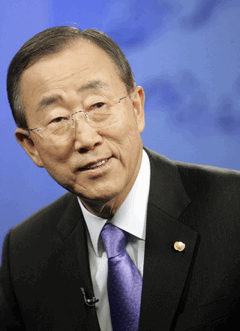
United Nations Secretary General Ban Ki Moon is convening a climate change summit, and has called climate change “the greatest collective challenge we face as a human family.” (Photo: UN Photo/Devra Berkowitz)
[THEME]
YOUNG: From the Jennifer and Ted Stanley studios in Somerville, Massachusetts, this is Living On Earth. I’m Jeff Young.
CURWOOD: And I’m Steve Curwood. With less than three months to iron out a new treaty to replace the Kyoto protocol, there’s a blizzard of climate change summits acomin’: New York, Pittsburg, Bangkok, Barcelona. All opportunities to reach agreement, but the climate remains uncertain for a deal. The United States has yet to match the emissions cuts promised by the Europeans and the Japanese.
And developing countries are still waiting for help from the richest nations to cut emissions and adapt to climate disruption. The U.S. and China together account for more than 40 percent of global warming gases, and the two have been negotiating extensively about how they might partner to move forward. Jennifer Morgan is director of the Climate and Energy Program for the World Resources Institute in Washington D.C.
MORGAN: The thing to note is that the U.S. and this new administration is actually pursuing climate change on a number of different fronts. They’re engaged in the UN negotiations, they’ve started this major economies forum where they’re bringing the major economies together, and they’re pursuing their bilateral relationships – a very important one – which is with China.
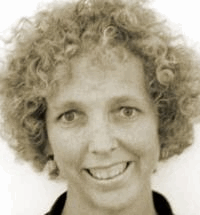
Jennifer Morgan
CURWOOD: What might be the first step that would show that there’s substance to this notion that the U.S. and China will work something out bilaterally in the context of the UN negotiations?
MORGAN: I think a good step would be actually some very specific and concrete, hopefully transformational partnerships on buildings – energy efficiency buildings – on carbon capture and storage. Both countries have a large coal base and they both need to figure out how to produce zero-emissions coal.
So, if there was a partnership where they both said we’re going to do a set of demonstration plants, together, to figure how we’re going to work this technology. If they were to do that on some solar technology, so some very specific, big technology projects.
That would be one thing. I think the other thing that would be very helpful is if both countries worked on how they’re gonna measure, report, and verify their emissions. What systems of transparency are they going to set up, and to really start building the capacity in China to do that kind of measuring, reporting, and verification, and the U.S. has obvious experience in this. So, those two areas, I think, are kind of the foundation, but also really looking transformationally how we’re going to decarbonize these two economies, which, you know, starts in Copenhagen, but is a way, much longer process to get there.
CURWOOD: In the context of these negotiations with China, a row has erupted over tariffs the U.S. is going to impose -- a tire tariff. This comes just at the moment the U.S. is trying to come together with China on a bilateral agreement around climate. Some might say that there might be domestic factors in both countries that might see it in their interest to have talks fall apart on the issue of trade.
MORGAN: I think that the trade agenda obviously is an incredibly hot, difficult, and challenging issue and it is also in the thick of the climate issue. There are proposals on Capitol Hill in legislation that China would certainly find completely unacceptable, and there are concerns, obviously, in the United States that feel that those types of measures are needed.
My hope is that we can find a solution where through a global agreement we see that actually these competitiveness concerns, we don’t need these additional trade measures in order to get a deal. I think that this is something that could really blow up in our faces if we’re not careful, and goes way beyond the climate agenda, and hasn’t yet really gotten the adequate attention that it needs.
CURWOOD: And then, of course, there’s Japan: the world’s second-largest economy. Its incoming prime minister says that he now wants to cut emissions by 25 percent over 1990 levels over the next ten years. Of course the condition is if only other developed countries set similar ambitious goals. So, how does Japan come out now in terms of leadership for action on climate change?
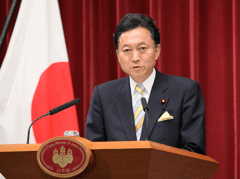
Japan’s new prime minister, Yukio Hatoyama, has pledged to cut Japan’s greenhouse gas emissions by 25 percent. (Courtesy of the Prime Minister of Japan and His Cabinet)
That’s the kind of dynamic that we need. That shared endeavor to save the planet and shift to a low-carbon economy. And I think the shift of Japan is very significant because they, in the past, have been quite negative on this. And this new government sees this, I think, as an opportunity.
Japan is highly efficient, the export potentials could be large for such a nation, and, you know, they’ve got the systems in place. And China, of course, is a key one for them, as well. They’ve got lots of bilateral relationships going there. So, I hope that Japan can provide some inspiration.
CURWOOD: Now, what about the African block? Last month there were a group of African countries that says that it needs, what? 60, 70 billion dollars a year to help deal with the effects of climate change. And now the prime minister of Ethiopia says, um, Africa’s not going to go along with the treaty unless the developed world responds.
MORGAN: Africa has, perhaps, the most at stake in this agreement along with the small island nations. If there is not an agreement in Copenhagen, and we don’t move towards this low-carbon economy, the impacts hitting Africa are really in the life and death category.
And therefore I think it’s completely understandable for Ethiopia and others to be raising the red flag, and saying this – this is about our, not just our economic wellbeing, it’s about our health, it’s about, you know, these people are so poor and the additional impacts of climate change, further droughts, food security issues are so dire that they, I hope, will be a formidable block moving forward.

United Nations Secretary General Ban Ki Moon is convening a climate change summit, and has called climate change “the greatest collective challenge we face as a human family.” (Photo: UN Photo/Devra Berkowitz)
CURWOOD: Jennifer Morgan is the director of the Climate and Energy Program for the World Resources Institute. Thank you so much, Jennifer.
MORGAN: Thank you.
[MUSIC: DJ Cam “Ghetto Love” from ‘Loa Project Vol.2’ (Laurant Daumail Productions - 2000)]
Related links:
- For more on WRI and climate change, click here
- The United Nations Framework Convention on Climate Change
Hold on Coal
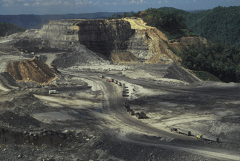
Mountain-top removal coal in Appalachia. (Courtesy of the Sierra Club)
YOUNG: In Appalachia’s coal country, the dispute over mountaintop removal mining has heated up, with activists blocking the gates to some mines and the Obama administration looking into some permits. The Environmental Protection Agency is focusing on 79 mountaintop removal sites, especially the valley fills. That’s where the waste rock and dirt is dumped, sometimes burying miles of nearby streams.
The EPA announcement sparked emotional response from both sides of this debate even though, so far, the agency hasn’t stopped any mining. Ken Ward, Jr.’s been watching all this closely. He’s a reporter for the Charleston Gazette in West Virginia. Ken Ward says EPA’s ultimate decision on these mines will largely rest on what becomes of the water.
WARD: EPA scientists believe that mountaintop removal is not only burying streams – hundreds of miles of streams – but they believe that this type of mining is damaging the water quality downstream from those valley fills.
Scientists are seeing impacts on water quality ranging from increased levels of toxic selenium to metals and other sorts of pollutants that are increased when there is mining upstream. One EPA study that’s been much quoted found that mayflies had disappeared all together downstream from valley fills. And EPA scientists see that as an indication that if, uh, those insects are gone that the stream overall in the ecological system there is not very healthy.
YOUNG: Now, these water issues that EPA is raising here – are these the kind of problems that could be easily resolved by tinkering with the permits, limiting the size of the valley fills, that sort of thing, or are they pointing to problems here that would be much more difficult to address?
WARD: Well, you really hit on the question. What remains to be seen is exactly what is EPA going to find in the end acceptable and not acceptable? They haven’t said they will veto any of these permits, but they just said they want to take a closer look at them.
And, you know, what the mining industry would like to know and I think environmentalists would like to know is exactly how big of a valley fill? How much stream does EPA say can be filled? How much downstream impacts is acceptable? And the EPA had really not said where that bar is going to be yet.
YOUNG: What about the legality of the fills themselves? The Bush administration made some changes to the regulations for clean water to basically allow that type of fill to be dumped into streams. Any indication here that the Obama administration is ready to revisit that?
WARD: Well, the Obama administration has said that what it has in mind is to take unprecedented steps to reduce the impacts of mountaintop removal. What the Obama administration has not really commented on is whether it will propose to rewrite the Clean Water Act – what’s called the “fill rule” – which the way it had been previously written before the Bush administration changed it. The fill rule, at least one federal judge said, outlawed valley fills all together. So it’s really – this is just a step in a process of trying to get at where is the Obama administration headed on this issue? We don’t really know for sure.
YOUNG: What was the reaction from West Virginia lawmakers when EPA said it was going to take a closer look here?
WARD: Well, it’s kinda interesting because previously there’d been several rounds of this with the Obama administration, where they’ve announced some actions on some mining permits.
And you typically then get this race by the politicians here to – who can ratchet up the rhetoric the highest against EPA and in favor of state’s rights and in favor of the mining industry. But this time, when EPA announced it wanted to take a look at these 79 permits it was a bit more muted of a response, not with the outrage and the rhetoric that we’d heard before.
YOUNG: What do you make of that somewhat muted response, and no response from Robert Byrd?
WARD: Well, Senator Byrd has been a very strong supporter of the coal industry his whole career. He’s been a very vocal supporter of mountaintop removal, but he was kind of hinting around that, you know, that maybe he was rethinking things, and, you know, you heard rumbles that there might be some new proposal or policy coming from Senator Byrd. It would certainly be interesting is Senator Byrd decided to engage in this and try to seek some middle ground or some solution to the problem.

Mountain-top removal coal in Appalachia. (Courtesy of the Sierra Club)
WARD: Well, yes. We want to watch these 79 permits and see which of them, if any, EPA relents and allows the Corps to issue, and look and see, well, what are the conditions in those permits? What sort of valley fills are proposed? What sort of changes does EPA press the companies to make in their mining plans? There’s a host of those sorts of things that environmental groups would like to see this administration do, and are pressing this administration to do. We need to watch and see what happens with this.
YOUNG: Ken Ward, Jr. of the Charleston Gazette. You can also read his blog, it’s called “Coal Tattoo”. Thanks, Ken.
WARD: Thank you, Jeff.
[MUSIC: Tom Verlaine “Meteor Beach” from ‘Around’ (Thrill Records - 2006)]
CURWOOD: Coming up, the City of Steel rebuilds green – a visit to Pittsburg. Keep listening to Living on Earth.
Related links:
- Check out Ken Ward Jr.’s blog on mining in coal country
- Learn more about the EPA announcement on mining permits.
Steel City Builds Green

The leaders of the world’s largest economies will meet here at the G-20, in Pittsburgh’s David Lawrence Convention Center. It also happens to be the world’s first green-certified convention center.
YOUNG: It’s Living on Earth, I’m Jeff Young.
CURWOOD: And I’m Steve Curwood. Climate change will be high on the agenda when the G20 convenes in Pittsburgh. Hardly a world capital, and Jeff, you went to Steel Town to find out why that was chosen as the host city for the economic summit.
YOUNG: Yeah, you know this has been a bit of a puzzler from the moment White House Press Secretary Robert Gibbs made the announcement.
GIBBS: One quick announcement before we get started.
YOUNG: Now, just listen to the White House press corps reaction here.
GIBBS: The United States will host the next G20 summit in Pittsburgh, Pennsylvania.
[LAUGHS AND SHUFFLING FROM AUDIENCE]
YOUNG: Well, that chuckling didn’t go over so well in Steel Town.
LEAHY: Of course, the Pittsburghers, we’ve kinda got our backs up straight. It’s like, why’s they laughin’ at our community? So, why Pittsburgh? Well, as we look at it, why not Pittsburgh?
YOUNG: Mark Leahy is showing me around the facility he manages, Pittsburgh’s David Lawrence Convention Center. That’s where the G20 leaders will meet, and it happens to be the country’s largest certified green building, as a plaque on the wall proclaims.
LEAHY: That is our certification.
YOUNG: There—there—there it is. Tells you what it’s all about. U.S. Green Building Council gold standard?
LEAHY: Gold standard. LEED gold 2003: Leadership in Energy and Environmental Design. That is our pride and joy, right there.
YOUNG: Nearly every scrap from the Convention Center’s kitchens gets composted, gray water is reused, natural light from louvered windows floods the massive meeting rooms, and the soaring, sloping roof circulates the air.
LEAHY: So, imagine several thousand people in a convention center. I don’t have any air or chilling or anything going on, and no lights on, so the energy savings is just tremendous.
[SOUND OF TRUCKS MOVING]
YOUNG: And it’s not just the convention center. Pittsburgh ranks seventh in the country in the number of green buildings, thanks largely to its biggest bank: PNC.

Pittsburgh’s biggest bank doesn’t just have green in its vaults. It has a fleet of LEED-certified green buildings and this “living wall.” (Courtesy of PNC)
YOUNG: Fred Solomon shows me PNC’s newest green buildings -- two high-rises, 64 green branch offices, and now, the country’s largest living wall: six stories of flowing, flowering greenery on display just in time for the G20 dignitaries.
SOLOMON: It’s not just the world’s leaders. It’ll be 3,000 journalists coming to Pittsburgh to see why Pittsburgh, why did the president pick this city? And we believe that our commitment to green, together with Pittsburgh’s history of overcoming difficult economic times, this was the can’t-miss location for the summit.
YOUNG: Take that, snickering press corps. This no rustbelt remnant. Pittsburgh’s steel helped build America, now the city’s rebuilding in green. Influential non-profits like the Heinz Foundation nudged the private sector toward efficiency and clean energy, and local government officials cleaned up old industrial sites for redevelopment.
Nearly one-third of the region’s technology jobs are now in green industries, and Pittsburgh’s research universities provide the creative juice for new green businesses. For a company called Plextronics it literally was juice.
[SOUND OF LIQUID SHAKING IN A JUG]
YOUNG: That liquid developed by a Carnegie Mellon professor is what Plextronics COO Glenn Thompson thinks could revolutionize the way we light our products and homes.
THOMPSON: You can hear it shaking here. The materials in here is one of the inks we would use produce, in this case, a light-emitting material – a light-emitting diode, for example.
YOUNG: Thompson showed me around the lab where 70 Plextronics employees develop printable circuitry. They hope to light consumer devices and generate solar power with inexpensive, non-toxic, thin films.
THOMPSON: The end of the day, you’ll see your television screen probably roll out of a tube some day and be pasted to your wall in your home. But white lighting is the real opportunity because we have the capability to then replace fluorescent and incandescent then with very low-cost, cool energy that can be driven by the photo cells that are on the outside of your building.
YOUNG: I’m wondering, growing up, did you ever dream that there would be something like this happening in Pittsburgh?
THOMPSON: Not in my wildest dreams, in all honesty. Uh, this was a steel town when I was a kid. It was dirty, it was very, very blue collar. I never dreamed that you’d see anything of this high technology come out of this area. It’s a real phoenix situation, it really is, it’s a rebirth.
YOUNG: It is remarkable that green has taken root in Pittsburgh at all considering its polluted past. Choking smoke shrouded the mill towns along the three river valleys. Nowhere did the smog take a greater toll than in the little town on Donora, just up the Monongahela River.
[SOUND OF PASSING TRAFFIC]
YOUNG: Among Donora’s vacant storefronts, there’s a new museum. It’s dedicated to the great smog of October 1948. Retired schoolteacher, Charles Stacy, remembers it well.
STACY: Oh, certainly I remember. I was a senior in high school at the time, and we had to walk to school through that. We couldn’t see the traffic signals, we couldn’t see the streetlights, and of course we had to be very careful that we didn’t fall off the curbs.
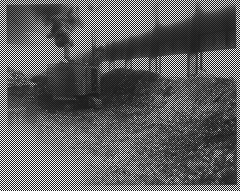
Pollution equaled progress for Pittsburgh and its mill towns, until the killer smog of 1948 took 20 lives in Donora. “We say clean air started here,” says Donora’s Charles Stacey. (Courtesy of the Donora Digital Collection)
STACY: Things got to be so bad that they had to make a temporary morgue on the lower floor because the funeral directors couldn’t handle all the bodies.
YOUNG: So, in the wake of this. I mean, people died, it was kind of hard to ignore the reality of it, but people still didn’t want to address it.
STACY: They didn’t wish to address it because this was their livelihood, and they would rather put up with the dirt and polluted air, and maybe poisons in the atmosphere, and so forth, just to maintain their jobs. And, we say that clean air started here and it focused attention on air pollution, but people died and we lost jobs, and the community is fallen on hard times as a result of that, and we hope that other communities learn their lessons from Donora.
YOUNG: In the sixties, Donora’s mills were among the first in the region to close. The closures continued through the seventies and eighties as the steel industry collapsed.
[SOUNDS OF STEEL MILLING]
YOUNG: You can still watch steel being made around here just a couple miles downriver from Pittsburgh in the town of Braddock where Lisa Roudabush is Mon Valley Works general manager for U.S. Steel.
ROUDABUSH: The Edgar Thompson Works was built in 1875. It was the first integrated steel facility in Pennsylvania. And right now, it’s the last operating steel facility in Pennsylvania. It’s pretty amazing –
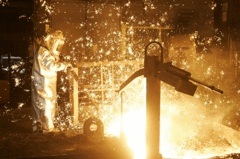
US Steel’s Edgar Thomson works is the last big steel mill in PA. Steel’s improved its energy efficiency and steelworkers hope their product will find new demand in clean energy products like wind turbines. (Courtesy of the World Steel Association)
ROUDABUSH: Well, we think steel is a very efficient material. We can make very lightweight cars out of steel. We do make the wind turbines out of steel. And I think steel is green.
YOUNG: Steel workers have embraced a green jobs agenda. The mayor of this mill town, John Fetterman, joins some steel workers for TV ads promoting a climate change bill.
[SLOW, SAD PIANO MUSIC]
FETTERMAN: We need a cap on carbon pollution. It’ll create jobs making things like solar panels and wind turbines. There’s 250 tons of steel in a wind turbine. You guys can handle that, right?

Wearing it on his sleeve: Braddock, Pa., Mayor John Fetterman has his town’s ZIP code tattooed to his arm. He’s hoping clean energy jobs will revive the economically distressed town.
FETTERMAN: Braddock is part of the fringe where unemployment consistently is above 30 percent, where we are the county’s poorest community.
YOUNG: You’d like to be working-class America but–
FETTERMAN: Absolutely. We—we someday aspire to be working-class America.
YOUNG: So, how real is this green thing that’s happening in Pittsburgh from your town’s perspective?
FETTERMAN: I think, you know, without trying to be negative in front of the G20, there’s a lot of great things to highlight about Pittsburgh, but I think it’s not a neat, you know, kind of Hollywood narrative where Pittsburgh gets its heart broken, loses a quarter of a million steel jobs, and now everything’s hunky-dory again. It really isn’t.

The leaders of the world’s largest economies will meet here at the G-20, in Pittsburgh’s David Lawrence Convention Center. It also happens to be the world’s first green-certified convention center.
[MUSIC: Johnny Hodges “Three And Six (aka Wounded Love)” from ‘Lush Life: The Billy Strayhorn Songbook’ (Verve Records - 1996)]
Related links:
- Hear Jeff Young talk with Braddock Mayor John Fetterman, who has high hopes for clean energy investment to revitalize his economically distressed town.
- Listen to Donora resident Dr. Charles Stacey give Jeff Young a tour of memorabilia in the Donora Smog Museum, which chronicles the killer smog of October, 1948.
- The David Lawrence Convention Center’s approach to green management of a large public building
- More on the killer smog of 1948 at the Donora Smog Museum
- More on John Fetterman’s hardcore approach to urban renewal in Braddock, Pa.
Cooking Up Healthcare Reform
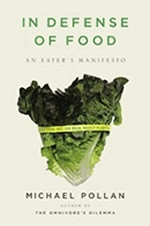
Michael Pollan’s newest book.
CURWOOD: Though the focus of the upcoming UN and G20 summits will be on climate change, at the moment, health care reform is dominating debate on Capitol Hill. But if you ask author Michael Pollan, he’ll tell you climate change and health care are closely related.
Our sugar- and fat-laden diet is based on fossil fuel, he says, and when you add up the global warming gases from agriculture, it’s more than what comes out of cars and trucks. Two out of three Americans are overweight, and that costs the health system billions of dollars a year. And Michael Pollan says if we want to cut health care costs and help save the planet it’s time to stop subsidizing the industrial production of junk food.
POLLAN: We’re very concerned, and rightly so, about soaring health care costs. We’re spending about $2.3 trillion on health, which is about twice as much as people do in Europe, and in Europe they have a healthier population. The focus in our discussions about this health care cost crisis has all been about the inefficiencies built into the system.
And I don’t think we’re paying enough attention to the factors outside of the system that are causing us to be so unhealthy. We have soaring rates of preventable chronic diseases. One of the big expenses for the health care system now, and certainly going forward, is type-II diabetes. Type-II diabetes is caused by several factors, but, uh, large shots of glucose to the metabolism are a very important one of them.
And you’ve got adolescents in this country that are on average getting 15 percent of their calories today from soda. Most of the experts that have looked at the question say that if you could reduce soda consumption – and not just soda, but all sweetened beverages: ice tea, Gatorade, all those products – you would help with that problem, and you would save an awful lot of money because every case of type-II diabetes costs on average about more than about $7,000 a year to treat, to maintain. And the mystery is why don’t we talk more about this as we’re debating our health care system?
CURWOOD: And why don’t we talk about this?
POLLAN: I think part of it is that it seems incredibly difficult to people to tackle the food system. It’s a more entrenched and powerful industry, even than the health care system. Uh, in the case of reforming health care you at least have all those powerful corporations that can’t afford their health insurance bills and they become allies of the president or congress in efforts to reform. Food – you don’t really have that yet. You have a situation where everybody likes cheap food, at least in the short term. So, I think what you need before you’re going to have a powerful movement to reform the food system is, in fact, the health insurance industry getting on your side.
And, that’s what I’m really hopeful about because if we do reform health care, even in a kind of diluted, mild way, and only get the insurance reforms that even the weakest bills provide for – which is to say, no more pre-existing conditions, that the insurance companies have to take everyone at the same price, and that they can’t toss you off the plan once you get sick. If we just get those three changes the health care insurers will recognize, I think overnight, that they have a powerful interest in preventing every case of type-II diabetes, every case of obesity, every case of heart disease. And they will then become powerful allies of the movement to reform the food system.
CURWOOD: How fair is it to point to the finger at the food industry, which supplies an abundance of inexpensive food, for what are basically unwise personal choices?

Michael Pollan
And that there is a real ethical and moral question about marketing unhealthy foods to children, which happens, of course, routinely if you’ve ever turned on the Cartoon Network. You know, maybe children should be protected from the food marketing marketplace, but then you have another area here; if you have a dollar to spend in the supermarket you will find yourself – and you don’t have a lot of money – they way our system is set up, you can get more calories per dollar of junk food than you can of healthy food.
You can get 1,250 calories per dollar of chips or cookies but only 250 calories of carrots or broccoli. Um, that is due to the fact that the farm policies we have are favoring the really unhealthy calories. We subsidize corn and soy, which are really the building blocks of fast food. We subsidize feedlot meat, we do a lot to ensure that fast food is cheap. So, I think the personal responsibility argument breaks down pretty quickly and I think you really need to look at the environment in which we’re eating and the system that is dictating the choices that we supposedly have.
CURWOOD: So, how receptive is the Congress to a change in agricultural policy? What kind of political will is there for reform?
POLLAN: There’s very little in Congress, you know, at least on the two committees that powerfully control our agricultural policies, and those are the agricultural committees of the House and Senate. These committees are really strongly dominated by agri-business, they consist of farm state legislators for the most part, backed by a lot of money from food manufacturers and buyers of cheap agricultural commodities, and they reflect those interests. And they need to represent eaters as well as farmers and food manufacturers.
CURWOOD: Michael Pollan, what relation does this debate over health care and food have to do with the question of sustainability?
POLLAN: Oh, it has everything to do with sustainability. I mean these problems are very closely linked. The problem as I see it in our food system is that as we have industrialized it, we have taken a system that is at its ecological heart, of course, a solar system. I mean the only way to get food calories is to use sunlight and photosynthesis to produce carbohydrates. I mean this is the basis of everything we eat.
You know, since World War II, we’ve increasingly replaced that solar energy with the power of fossil fuel. We use fossil fuels to make the fertilizers, to make the pesticides, to drive the farm machinery, and then to process the food and move it all around the world. In the process of doing this, we’ve moved toward a highly productive, highly efficient monocultures. So when you have that kind of agriculture, which is incredibly productive -- and we have to grant it its power to feed us very, very cheaply – it tends to push you in the direction of highly processed, very unhealthy food.
CURWOOD: So, you’re saying, change the way we eat and we can address climate change and be healthier and cut the cost of health care?
POLLAN: And reduce our fossil fuel consumption. It’s kind of amazing you could get all those benefits. But it won’t be easy to squeeze the fossil fuel out of the food system. Means going back to much more diversified farming, going back to more regional agriculture, and all of which is going to take a lot more farmers than we have right now. It won’t be easy, but in the same way we need to learn how to run an industrial civilization without cheap fossil fuel, because we can’t count on it in the future and we can’t afford what it’s doing to the climate; we’re gonna need to figure out how to run a food system using solar energy again.

Michael Pollan’s newest book.
POLLAN: I think we need to look at the set of incentives we have in our agricultural system. I think it’s important to understand that it’s not a free market system, that since the Depression, the government has played a very important role in the design and functioning of our food system. The incentives that we have designed for farmers, the way we support them with our subsidies, and other programs, has been to strongly encourage them to overproduce – to produce more corn, and soy, and wheat than we can eat.
The reason for that is, if you can get the farmers to overproduce, the price of food comes down, and the buyers of these cheap agricultural commodities, everybody from Coca Cola to KFC to McDonalds, you know, loves that because their raw material costs goes down. So, the challenge is then to design a set of incentives that gets them to grow more food rather than raw materials for fast food that gets them to take better care of the environment. In other words, that stresses quality of farming, rather than quantity of farming.
And then you’ve got what we can do as individuals, and what I call voting with your fork. For me that came, you know, I thought a lot about that and to the extent that we can eat real food, and not too much of it, and mostly plants. You’ll be doing a lot for your health and you’ll be doing a lot for the environment. So, our eating habits, you know, look, what happens on our plate represents our deepest, most powerful engagement with the rest of the world.
CURWOOD: Michael Pollan is a professor of journalism at the University of California at Berkeley, and author of “In Defense of Food: An Eater’s Manifesto”. Thank you so much, Michael.
POLLAN: Thank you, Steve, always a pleasure.
[MUSIC: Jefferson Airplane “Wild Thyme” from ‘After Bathing At Baxters’ (Legacy Records 2009)]
YOUNG: Well, just ahead we’ll talk with someone who’s tackling these food issues one school lunch at a time – the Renegade Lunch Lady. Stay with us on Living on Earth.
ANNOUNCER: Support for the environmental health desk at Living On Earth comes from the Cedar Tree Foundation. Support also comes from the Richard and Rhoda Goldman fund for coverage of population and the environment. And from Gilman Ordway for coverage of conservation and environmental change. This is Living On Earth on PRI, Public Radio International.
Related links:
- Click here to read Michael Pollan's article, “Big Food vs. Big Insurance,” in the New York Times.
- For more on Michael Pollan, click here.
Note on Emerging Science
YOUNG: It’s Living on Earth, I’m Jeff Young.
CURWOOD: And I’m Steve Curwood. Just ahead, a tour of the tiniest farm in New York City, but first this note on emerging science from Christine Parrish.
[MUSIC: “PINBALL WIZARD” BY THE WHO]
PARRISH: Tommy is up against a new pinball wiz-kid: a tiny creature that slams around photons to score big points for solar power.
[THEME MUSIC]
PARRISH: The new kid on the block is actually a very old organism called the diatom. . It's been around since the dinosaurs. And this single celled organism has a unique feature: it essentially builds its own glass house. Diatom shell walls are made of silica and full of tiny holes. These create a kind of fine mesh screen – the perfect nano-structure for trapping light. But to collect sunlight effectively, the silica must be transformed into photovoltaic material. So, the university researchers put the diatoms on a titanium dioxide diet—and the diatoms gobbled it up. Then, the diatom shells were dyed to attract even more photons.
And the engineers scored a triple ball. Photons attracted to the dye enter the screen-like shell and ping around in a frenzy – just like a pinball. Photons trapped inside the shell produce three times as much energy as they currently do in conventional solar cells. As an added bonus, they can even do it on cloudy days. And the low-tech diatom can easily and cheaply be grown in a lab. Solar panels using diatoms won’t be on the market tomorrow, but it might not be long. All the researchers need is a cash backer to get their ball into play. That’s this week’s note on emerging science. I’m Christine Parrish.
[THEME]
Related link:
For more on diatom power, click here.
Lunch Lady Dishes it Out

Ann Cooper, the Renegade Lunch Lad
YOUNG: More than thirty million kids in this country get free or reduced-price school lunches every day, but the nutritional value of those meals is in question.
[SOUNDS OF BUSY ELEMENTARY SCHOOL LUNCH ROOM]
YOUNG: Living on Earth’s Jessica Ilyse Smith checked out what kids were eating at the Josiah Quincy Elementary School in Boston’s Chinatown.
KID: Chicken nuggets with French fries.
SMITH: Was it good?
KID: Yes.
KID: We’re drinking milk.
[SOUNDS OF SLURPING THROUGH STRAW]
SMITH: And, do you ever get school lunches?
KID: No…
SMITH: What did you eat instead?
KID: Umm, I ate a yogurt. Umm, I ate a peanut butter and jelly sandwich and I have an apple in my lunch box.
SMITH: And what did you eat?
KID: Chicken nuggets with fries.
SMITH: And, what’s your favorite school lunch?
KID: Pizza! And chicken nuggets.
KID: Pizza!
YOUNG: Though the menu’s quite different at the Boulder Valley school district in Colorado. That’s where chef Ann Cooper directs nutrition services. She calls herself the Renegade Lunch Lady and she’s picking a food fight over the nation’s school lunch program. Ann Cooper, we just heard what those kids had for lunch, is that typical?
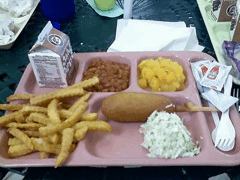
School lunch
YOUNG: What would you be feeding those kids, instead?
COOPER: So, in Boulder Valley school district where I’m currently the director of nutrition services, instead of chicken nuggets we would serve roast chicken. So a typical day might be roast chicken, roast potatoes, some kind of vegetable, full salad bar, organic regional milk and fresh fruit. We need to serve our kids real food!
YOUNG: Give me a sense of what’s happening in the schools where you have managed to start changing the meals – how do the kids respond?
COOPER: You know, like anything else, not every kid is going to like everything right away. So, you know, some of the kids aren’t going to love it, but then you’ve got to work with the kids. You need to do tastings, farm-to-school programs, hands-on experiential learning in cooking and gardening classes. But it works, kids will eat the food! But you have to work with them, they have to participate, and the food has to be good.
YOUNG: How do we get to where we are, anyway? I mean you listen to parents – parents are always saying you are what you eat! And you listen to politicians – politicians are always saying the kids are our future! So, why is it we’re feeding our future junk?
COOPER: [chuckles] You know, when the national school lunch program started about 60 years ago, it was really all about malnutrition and making sure that our kids ate better food, but about 30 years into the program, about half way through, all the original lunch ladies needed to retire. And, boy that 30-year-old equipment was very tired.
So schools were looking at this big infrastructure need – all this new equipment and all this new hiring. At about that same time we were seeing a lot of highly processed food and a lot of technologies coming out of the war that now had peacetime uses. And all the sudden big businesses such as school districts were kind of scratching their heads, going what do we do next? They said, oh you don’t need lunch ladies that are trained and you don’t need new equipment! Here! We have all this processed food. And because the way the USDA commodifies corn and soy, much of that processed food was really cheap. So, we started down this road of really cheap, processed food in schools.
YOUNG: Give me a sense of the importance of the school lunch program.
COOPER: You know, there’s 1.1 million hungry children every single day in this country, and that for most of those children they get the largest component of their calories from the national school lunch program. The national school lunch program, especially in this economy, is what keeps these children functioning, alive and healthy. And if the food they’re getting isn’t helping to do that, we’re really, really making a mistake.
YOUNG: Well, what’s happening now that gives you reason to hope that you might be able to change things?
COOPER: You know, I’m so optimistic at this point. First of all, we have a president who mentions school lunch and health and children in the same paragraph. The last president who mentioned school lunch was Reagan. He made ketchup a vegetable. So, that gives me great room for optimism. We have a first lady who’s growing a garden for kids on her front lawn – the front lawn of the White House. I mean I’m super optimistic because I think we have an administration and a USDA and Department of Education that really understands the importance of fixing this problem.
YOUNG: Now, Congress, at some point, is going to have to take another look at the very important Child Nutrition Act. The lawmakers have to take a look at it and decide how they’re going to renew it. What opportunities does that present?
COOPER: Well, I would tell you what I believe – that in my perfect world if I could make the decisions I would say we should add a dollar to the reimbursement rate, but have that dollar specifically given a priority to fresh fruits, fresh vegetables, whole grains, and regionally procured foods.
I think we need to allocate money to build new kitchens; we need to allocate money for a training program so that lunch ladies all across the country could get the training to go from processed foods to fresh foods. I think we should start something called the Culinary Corps. Where, you know, we graduate 30,000 culinary students a year from culinary schools and many of them aren’t going to get jobs because the restaurant industry isn’t doing so well. So what if we have tuition reimbursements paid for by the government that would send those culinary students into schools to help cook and teach cooks for schools.
And finally, we need a national marketing campaign. We need to help kids understand that healthy, delicious food can also be food they wanna eat. So we need to make school food cool food.
YOUNG: An extra dollar per meal for that school lunch program – is that what we’re talking about?

Ann Cooper, the Renegade Lunch Lady
YOUNG: So, that’s how you would pitch this, as look I know it’s a lot of money, but this is an investment.
COOPER: It’s absolutely an investment. Research has shown that the life expectancy and achievement gaps between rich and poor kids has grown and grown and grown. We now have a generation of at-risk kids who can’t think at school and can’t do well in school, because they’re hungry and they’re malnourished. That’s just not the America that we all want, that’s not the America we want for kids across this country.
YOUNG: It was Harry Truman who set this program up, right?
COOPER: Correct.
YOUNG: Harry Truman said, “No nation is healthier than its children or more prosperous than its farmers.” What do you think old ‘give em heck’ Harry would say if he saw the state of our kids’ health and our farmers’ prosperity now?
COOPER: I think and I hope he would be disgusted. I think and I hope that he would say, this does need to be a national mandate. That this does need to be a change that we not only can make, but have to make. That we have a moral imperative to take care of our children.
YOUNG: Ann Cooper, the Renegade Lunch Lady. Thanks very much.
COOPER: Thank you.
[MUSIC: Trout Fishing In America “Why I Pack My Lunch” from ‘My Name Is Chicken Joe’ (The Secret Mountain 2009)]
Related links:
- Click here to learn more about the renegade lunch lady.
- Learn more about the National School Lunch Program.
Truck Farm

Ian and Curt stand next to their pickup truck farm. (Photo: Jessica Ilyse Smith)
[SOUND OF TRUCK STARTING]
CURWOOD: Rev up the engine; throw that truck into gear; and be careful - don’t shake the tomatoes off the vine! Such is the life of Ian Cheney and Curt Ellis, who take the term “truck farming” to a whole new level in New York City. Living On Earth’s Jessica Ilyse Smith took a trip to the Big Apple, to dig her fingers in the dirt and find out what - besides a tree – grows in Brooklyn.
SMITH: Brooklyn isn’t known as a hotbed of organic vegetable gardening, but then again neither are flatbed trucks.
CHENEY: We’re leaning on the back of my granddad’s old 1986 Dodge pickup truck, which is now filled with vegetables.

(Photo: Jessica Ilyse Smith)
[TRUCK ENGINE SOUND]
CHENEY: Lots of trucks in Brooklyn, not a lot of farms.
SMITH: When Ian and Curt Ellis moved to New York they wanted to grow their own food, but space was an issue. So, Curt says they took a cue from others who were growing food in the city.
ELLIS: There’s essentially a green roof here in the bed of the pickup, and we’re using it to grow food.
SMITH: In fact, they sought out rooftop gardeners to find out how to garden with minimal soil.
CHENEY: The technology is pretty elegant and pretty simple. It’s a plastic membrane on the bottom of the truck that prevents the roots from winding down into the gas tank.
SMITH: On top of this membrane, a plastic structure that looks like an egg carton fills with water to hold moisture in the soil. When it rains, water that doesn’t fit in the small cups drains out of the truck. Then a layer of lightweight soil is covered by potting soil and compost.
CHENEY: A lot of this basil is ready to be picked.
[SOUND OF BASIL BEING PICKED]
MAN: Oh, it’s like a cooking herb, right?
SMITH: A man from the neighborhood stops by the truck.
CHENEY: Take a look at it, it smells really good.
SMITH: With a big grin, the passerby samples the locally grown basil.
MAN: Yeah, yeah it’s good when you put it on your meat.
SMITH: Neighbors are welcome to graze. And bags of fresh pickings are delivered when there is an ample harvest to people who sign up around the city.
CHENEY: This is community-supported agriculture, in which people buy a share of your farm ahead of time.
SMITH: Ian says that about 20 members subscribe to the CSA and get fresh salad-makings, herbs and wickedly hot peppers throughout the season.
CHENEY: It’s probably New York’s tiniest CSA, people pay $20, but it turns out they’ve been able to get a fair bit of produce out of the back!
[SOUND OF TRUCK]
SMITH: The urban farmers have found a way to grow a lot of vegetables in a truck bed that’s only five by eight feet.
CHENEY: This lettuce is really ready to be eaten.
[SOUND OF LETTUCE BEING PICKED]
SMITH: Ian picks a few leaves of lettuce and then jumps into the driver’s seat.
[ENGINE SOUND]
SMITH: Curt navigates by iPhone.
ELLIS: Bear right onto Lafayette here.
SMITH: Driving through the dense Brooklyn traffic, the farmers wave to people on the street who look at the farm with equal parts bewilderment and joy. Curt says this farm brings out the childish sense of wonder in almost everyone.
ELLIS: It’s kind of amazing how many people busily making their way to work, stop and smile and laugh when they see that there’s a farm growing on the back of a truck!
SMITH: On the side of the road a crew of construction workers notices Truck Farm drive by.
WORKER: We see this truck, we crack up…it’s unbelievable.
SMITH: Farming is not new to Ian and Curt. In 2004, the two teamed up to grow corn in Iowa and turned their experience into the documentary, King Corn. In Iowa, they grew one acre of conventional corn, using the techniques of modern industrial agriculture.
ELLIS: We used genetically modified seeds and anhydrous ammonia and nitrogen fertilizer and chemical pesticides.
SMITH: During the filming, they were shocked to learn that their bounty would not end up directly on people’s plates, but instead would be processed into high fructose corn syrup for soft drinks, and fed to cattle.
ELLIS: We’re gonna make a left up here.
SMITH: Now, the filmmakers by day—and farmers in their spare time—plan to turn their current adventures into another documentary to illustrate the creative ways people can grow food in the city. And they hope Truck Farm shows that healthy foods can be grown in neighborhoods where fresh produce is generally not found.
ELLIS: Right now, we’re in the Gowanus neighborhood of Brooklyn. It’s a pretty industrial neighborhood and there are no large supermarkets in Gowanus.
SMITH: Curt scans the landscape of used car lots and soda-selling corner stores and says he wants to encourage something different.
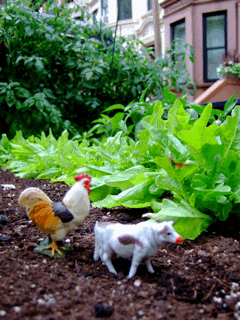
Neighbors have placed tiny plastic cows and chickens in the truck to graze between the rows of vegetables. (Photo: Jessica Ilyse Smith)
[SOUND OF TRUCK DRIVING BY]
CHENEY: The truckers have the best view, they can see down into the truck.
ELLIS: And they could have the biggest farms, you know? I mean look at that! That would be a beautiful farm!
CHENEY: A tow-truck farm would be good!
SMITH: Farming in the truck is fun, but Curt says he and Ian are also on a mission to improve people’s health by giving them more ways to get fruits and vegetables.
ELLIS: The CDC’s statistic is that one in three current first- or second-graders is on a path to develop Type 2 diabetes, and if we don’t change the way we eat, we’re gonna be in a serious problem in terms of healthcare in this country.
SMITH: They say Truck Farm can demonstrate that access to fresh produce doesn’t have to be a far-off dream.
CHENEY: I mean not that Truck Farm is going to feed the world, but it sure is an example of how we need to start thinking outside of the box about how we can feed the world in a different way.
ELLIS: Think inside the bed.
CHENEY: Think inside the bed of the truck.
SMITH: And, Ian says Truck Farm could even help the ailing auto industry…

Caption: Ian and Curt stand next to their pickup truck farm. (Photo: Jessica Ilyse Smith)
SMITH: Pedal to the metal, this agrarian duo drives off through the New York traffic, hoping to inspire future urban farmers. For Living on Earth, I’m Jessica Ilyse Smith in Brooklyn.
[MUSIC: Jenny Scheinman “I Heart Eye Patch” from ‘Crossing The Field’ (Koch Records 2009)]
Related link:
Click here for videos, photos and more information on Ian, Curt and the Truck Farm.
CURWOOD: On the next Living on Earth, a new health challenge. Sudden Aspen Decline brings a sad change to the forests of the Rockies.
WORRALL: It means more or less, very long term, semi-permanent loss of aspen on a lot of these sites, which a lot of people don’t want to see.
CURWOOD: What’s behind the death of the trees, and what might be done to stop it. Next time on Living on Earth.
[SOUNDS OF BIRDS]
YOUNG: We leave you today in the Brazilian state of Mato Grosso, near the Rio des Mortes. At sunrise the River of the Dead comes alive with the sound of birds.
[SOUNDS OF BIRDS]
YOUNG: Toucans, flycatchers, parakeets, antbirds, pygmy tyrants and macaws – all vie for attention.
[SOUNDS OF BIRDS]
YOUNG: There are over 800 species of birds in Mato Grosso. Living on Earth’s Bruce Gellerman captured this recording in one of the most agriculturally productive, and threatened ecosystems on the planet.
[SOUNDS OF MANY CHATTERING BIRDS]
YOUNG: Living on Earth is produced by the World Media Foundation. Our crew includes Bobby Bascomb, Eileen Bolinsky, Ingrid Lobet, Helen Palmer, Jessica Ilyse Smith, Ike Sriskandarajah, and Mitra Taj, with help from Sarah Calkins, Marilyn Govoni, and Sammy Souza.
CURWOOD: Our interns are Quincy Campbell and Nirja Parekh. Jeff Turton is our technical director. Alison Lirish Dean composed our themes. You can find us anytime at loe dot org. I'm Steve Curwood.
YOUNG: And I'm Jeff Young. Thanks for listening.
ANNOUNCER: Funding for Living On Earth comes from the National Science Foundation supporting coverage of emerging science. And Stonyfield farm, organic yogurt and smoothies. Stonyfield pays its farmers not to use artificial growth hormones on their cows. Details at Stonyfield dot com. Support also comes from you, our listeners. The Ford Foundation, The Town Creek Foundation, and The Oak Foundation supporting coverage of climate change and marine issues. The Rockefeller Foundation and its campaign for American workers. More at rockfound dot org. And Pax World Mutual Funds, socially and environmentally sustainable investing. Pax world for tomorrow. On the web at pax world dot com.
ANNOUNCER 2: PRI Public Radio International.
Living on Earth wants to hear from you!
Living on Earth
62 Calef Highway, Suite 212
Lee, NH 03861
Telephone: 617-287-4121
E-mail: comments@loe.org
Newsletter [Click here]
Donate to Living on Earth!
Living on Earth is an independent media program and relies entirely on contributions from listeners and institutions supporting public service. Please donate now to preserve an independent environmental voice.
NewsletterLiving on Earth offers a weekly delivery of the show's rundown to your mailbox. Sign up for our newsletter today!
 Sailors For The Sea: Be the change you want to sea.
Sailors For The Sea: Be the change you want to sea.
 The Grantham Foundation for the Protection of the Environment: Committed to protecting and improving the health of the global environment.
The Grantham Foundation for the Protection of the Environment: Committed to protecting and improving the health of the global environment.
 Contribute to Living on Earth and receive, as our gift to you, an archival print of one of Mark Seth Lender's extraordinary wildlife photographs. Follow the link to see Mark's current collection of photographs.
Contribute to Living on Earth and receive, as our gift to you, an archival print of one of Mark Seth Lender's extraordinary wildlife photographs. Follow the link to see Mark's current collection of photographs.
 Buy a signed copy of Mark Seth Lender's book Smeagull the Seagull & support Living on Earth
Buy a signed copy of Mark Seth Lender's book Smeagull the Seagull & support Living on Earth

